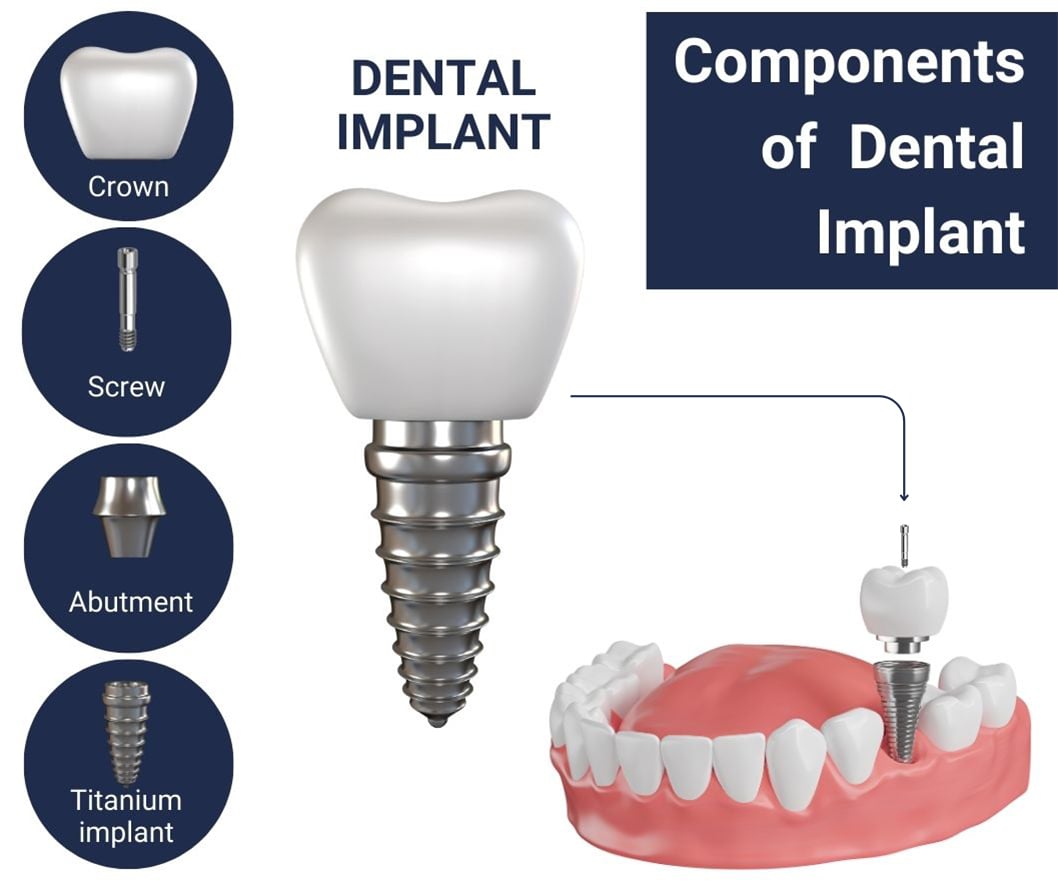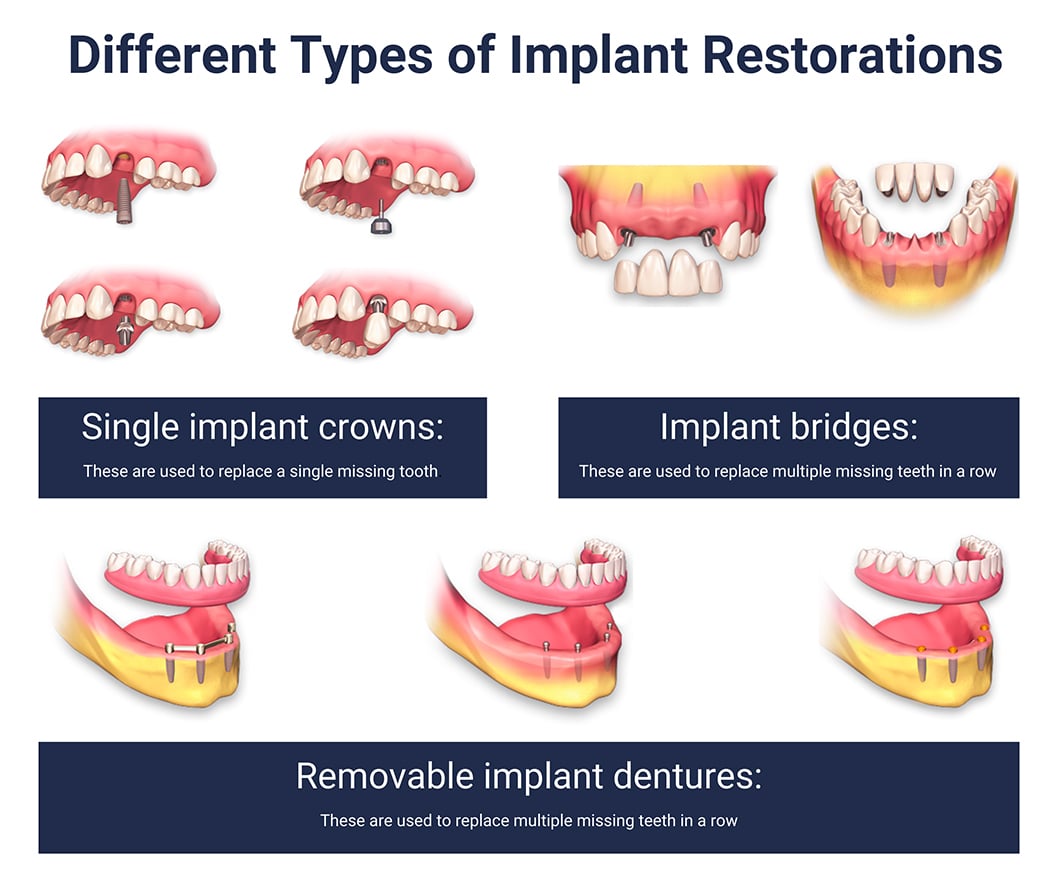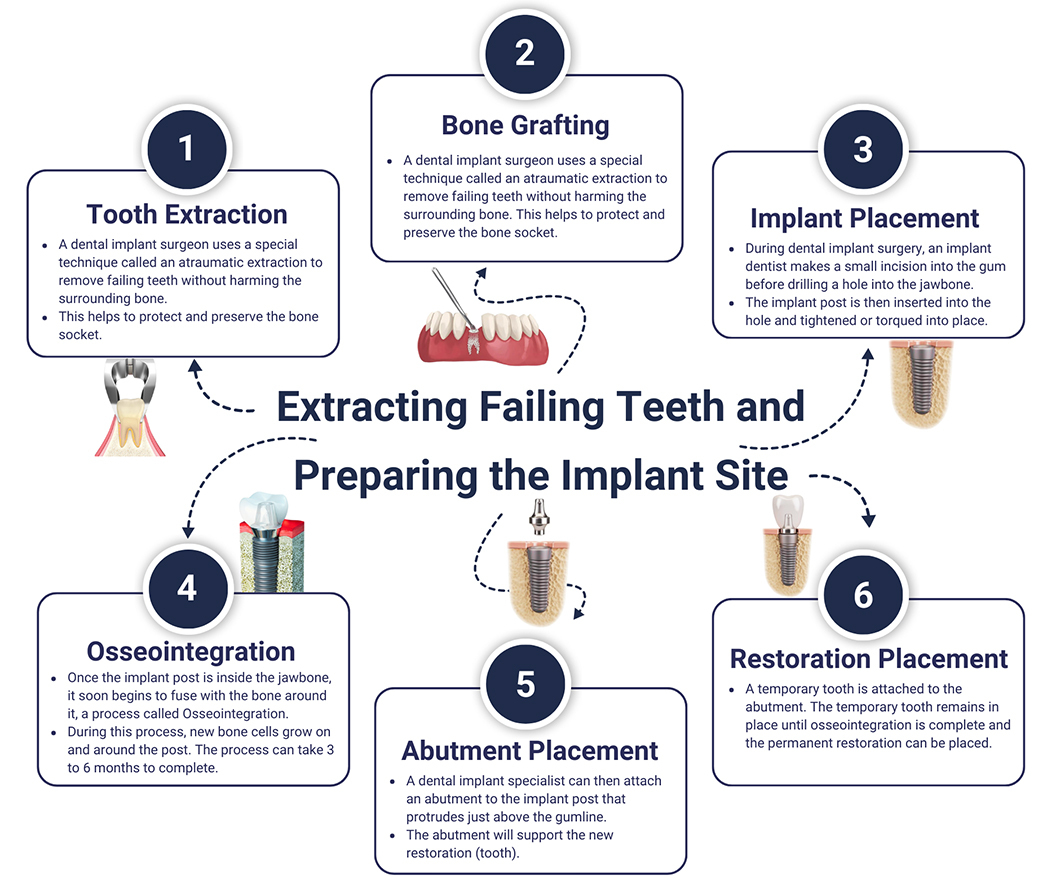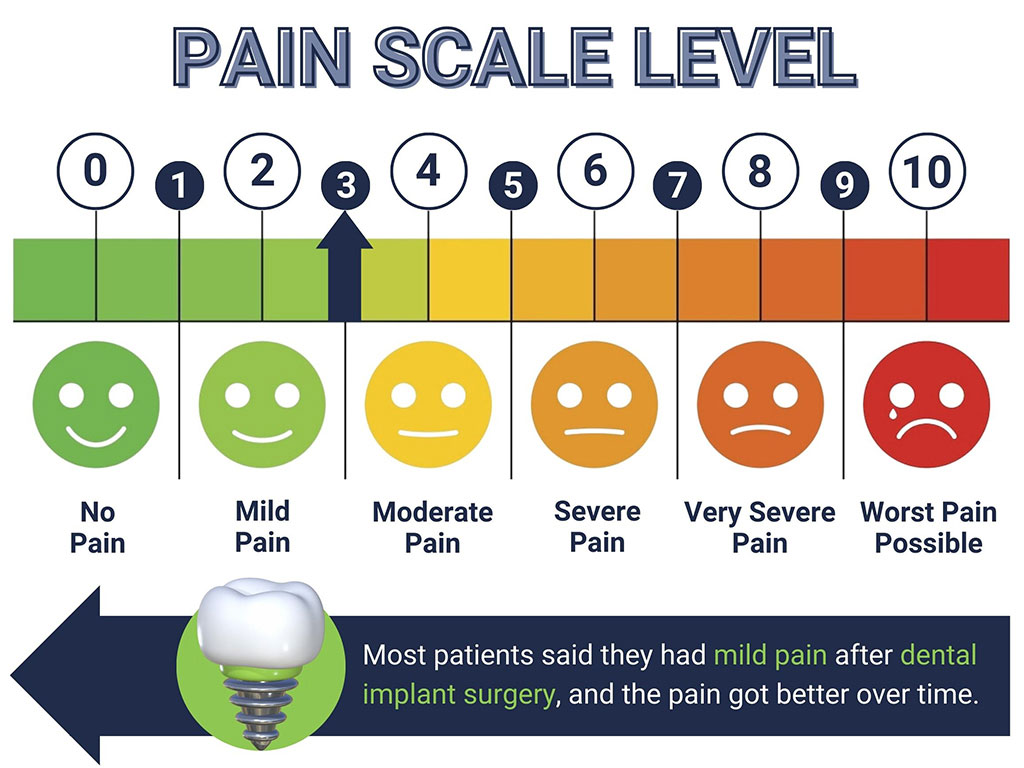Table of contents
To reduce anxiety, postoperative pain, and discomfort, our dentists inform patients about implant placement surgical procedures and anticipated pain levels. A thorough discussion is crucial to reduce patients’ fear and stress. The surgical procedure for implant placement is less painful than a tooth extraction, with less postsurgical pain and restricted daily activities.
Is Dental Implant Surgery Painful? Here’s What to Expect
Losing teeth is miserable, affecting your ability to eat properly and smile and talk confidently. Even if the missing teeth are not in your smile line, it’s still important to replace them, as your teeth are designed to work together. The loss of just a single tooth affects the health of your remaining teeth, allowing them to shift position into the gap left behind, destabilizing them and creating unsightly gaps between them that can be hard to put right later.
If you are missing teeth or have teeth that are failing and need to be removed, you may have already researched how best to replace them. You will almost certainly have discovered that dental implant surgery is one of the best long-term solutions, providing a reliable treatment outcome with a very high success rate. However, implant surgery involves a small procedure to insert the implant post or screw directly into the jawbone. Not surprisingly, some people find the thought of this surgery somewhat alarming and are concerned it will be painful. The question of how painful is dental implant surgery is very common and is likely asked by most patients considering this treatment.
In this article, we will discuss what’s involved with dental implant surgery so you understand how the process works, the potential pain this treatment may cause, and how best to avoid or minimize it.
What’s Involved with Dental Implant Surgery?
Anyone considering implant surgery needs to understand how the process works. First, when you see an implant dentist, Dr. Rahmani, he can assess your dental and general health to ensure this is the right treatment for your needs. While implant surgery is suitable for most people, there can be some circumstances where it is not an option, such as when a person has an autoimmune disorder or another health condition that could affect healing, but this situation is relatively rare.
Most people can benefit from dental implants, especially those that are older. Age is certainly no barrier to treatment.
Understanding Dental Implant Components
- Implant screw or post: This is the part of the implant that is inserted into the jawbone.
- Abutment: This is the part of the implant that connects the implant screw to the final implant restoration.
- Final implant restoration: This is the part of the implant that is visible in the mouth. It can be a crown, bridge, or denture.

Different types of implant restorations
- Single implant crowns: These are used to replace a single missing tooth.
- Implant bridges: These are used to replace multiple missing teeth in a row.
- Removable implant dentures: These clip firmly onto the dental implants.

Read more: Three Dental Implant Types: Which is Right for You?
Why see an implant specialist?
There are many different implant systems, so seeing an implant specialist such as Dr. Rahmani, who has experience using a wide range of different implants, is important, especially if you require more complex treatment.
Extracting Failing Teeth and Preparing the Implant Site
If you have teeth that are failing, implant treatment can begin when they are removed, especially if you see an implant specialist like a periodontist Dr. Rahmani.
- Tooth extraction: He can use a special technique called an atraumatic extraction to remove failing teeth without harming the surrounding bone, helping to protect and preserve the bone socket.
- Bone grafting: He may also place some bone grafting material into the bone socket, a technique known as bone socket preservation. The bone grafting material helps strengthen the jawbone, ensuring that once the implant is placed, it can bond properly with the surrounding bone. Sometimes this procedure is carried out at the same time as inserting the dental implant. Other times it may be necessary to carry out a bone graft beforehand and leave it to heal for 3 to 6 months.
- Implant placement: During dental implant surgery, the dental implant dentist Dr. Rahmani makes a small incision into the gum before drilling a hole into the jawbone. The implant post is then inserted into the hole and tightened or torqued into place.
- Osseointegration: Once the implant post is inside the jawbone, it soon begins to fuse with the bone around it, a process called Osseointegration. During this process, new bone cells grow on and around the post, and sometimes the implant post is specially treated to encourage Osseointegration. The process can take 3 to 6 months to complete, after which time the implant should be strong and stable and easily able to support a new restoration.
- Abutment placement: The implant dentist Dr. Rahmani can then attach an abutment to the implant post that protrudes just above the gumline. Options for abutment placement:
- Same-day abutment placement: The abutment is placed on the same day as the implant surgery. This allows the dentist to attach a temporary tooth to the dental implant.
- Delayed abutment placement: The abutment is placed several months after the implant surgery, once osseointegration is complete.
- Restoration placement: A temporary tooth is attached to the abutment. The temporary tooth remains in place until osseointegration is complete and the permanent restoration can be placed.
Dental implant treatment is a complex process, but it is a very effective way to replace missing teeth. Dental implants are long-lasting and durable, and they can help to improve your oral health and overall appearance.

So, How Painful Is Dental Implant Surgery?
Dental implant surgery is a common procedure used to replace missing teeth. It is a safe and effective procedure, but it is important to be aware of the potential pain and discomfort that can be associated with it.
You can rest assured the surgical procedure will not feel painful. Your implant dentist, Dr. Rahmani, will ensure the implant site is thoroughly numbed before inserting the dental implant. As the anesthetic wears off, you may experience some discomfort. Often, it’s mild enough (1-3 using the numerical rating scale (NRS)) to be controlled with over-the-counter pain medication; otherwise, your implant dentist can prescribe stronger medicine.
Generally, a single tooth implant will cause minimal discomfort, and it’s not uncommon to feel no discomfort at all after this surgery. Usually, the most uncomfortable part of dental implants treatment is likely to be when the gum tissue is cut to expose the underlying bone.
If you receive multiple tooth implants such as All on 4 implants or full mouth implants, you might have some discomfort afterward, possibly facial swelling and bruising.

Dr. Rahmani from NYC Dental Implants Center, will give you lots of helpful advice and instructions on caring for your implants after surgery, including the best foods to eat while your implants heal. Following his instructions closely will help you minimize discomfort or pain and aid healing.
Usually, the pain or discomfort should disappear within a week to 10 days. You should contact our dental implant office for further advice and possible treatment if it continues.
How Your Dental Implant Dentist Can Help Minimize Pain and Discomfort
When you choose a dental implant dentist, make sure they use computer-guided surgery, an advanced technique that helps minimize pain and discomfort during and after surgery. For this treatment, your implant dentist will take a cone beam CT scan of your mouth, producing high-quality 3-D images that allow them to plan your implant surgery precisely.
Using this scan, they can determine where to place each dental implant, avoiding essential structures like sinus cavities, nerves, and blood vessels. They can also see how the implants will look once fully restored, checking that they will look great and are fully functional. Sometimes when an implant is improperly placed, it is trickier to restore it correctly, and it ends up being a compromise between appearance and function.
Once your implant plan is finalized, a surgical stent is generated, allowing your implant dentist to replicate the plan exactly during surgery. The stent is a template that fits over your gum, guiding your implant dentist so they know where to insert the implant, the depth, and the angulation.
Computer-guided surgery helps ensure the actual surgery is quicker and smoother, with minimal incisions needed. Consequently, pain and discomfort are minimized, and healing should be faster and more comfortable.
Using advanced laser dentistry helps reduce this discomfort even further, minimizing or eliminating bleeding as the laser energy automatically seals any blood vessels. Laser dentistry is highly accurate, and afterward, there is minimal swelling, and recovery is faster.
Despite any discomfort being easy to manage during implant surgery, some patients still feel apprehensive or nervous about this treatment, especially those requiring lengthier or more complex implant surgery. In this case, sedation dentistry can be useful.
Overcoming Dental Fears and Anxieties with Sedation Dentistry
Dental fears and anxieties are common, and dentists are experienced in helping patients overcome these feelings, often by using sedation dentistry to enable them to have treatment comfortably. Various levels of sedation can be provided, ranging from very mild sedation in the form of nitrous oxide right up to intravenous sedation, where patients feel so sleepy they may actually fall asleep during treatment.
Nitrous oxide. Nitrous oxide is better known as laughing gas and is very mild and is given via a small mask that fits over your nose that you wear for the duration of surgery. It takes effect within a few seconds, producing a feeling of relaxation and possibly mild euphoria. Your implant dentist can adjust the level of gas provided to ensure you feel comfortable during your treatment. Once complete, they may give you pure oxygen to help eliminate the laughing gas more quickly from your body.
Oral sedation. Oral sedation is where an oral sedative is given in pill form shortly before treatment, so it has taken effect by the time you sit in the dental chair. It is an effective treatment to help you feel more relaxed and can also be combined with laughing gas for greater impact.
Intravenous or IV sedation. Intravenous or IV sedation is given through a vein in the crook of your elbow or the back of your hand, inducing feelings of deep relaxation. It is ideal if you require lengthy or complex treatment, and although you may feel very sleepy, you will still be able to respond to questions from the dental team, and you are closely monitored throughout your treatment to ensure you remain safe. Afterward, you will need to remain in the dental office for a while to ensure you are okay to go home. Because the sedative most likely contains an amnesiac, it’s unlikely that you will remember anything about the surgery, which is perfect for anyone with dental fears or anxieties.
If you are concerned that surgery will be painful, talk to your dentist about your feelings. They will be able to reassure you and can explain how they will minimize pain and discomfort in your situation. It’s well worth trying to overcome any concerns about implant surgery because dental implants are such a good solution for tooth loss. No other form of tooth replacement offers such a long-term solution, and the implant posts also help protect your jawbone, protecting your oral health.
If you have any questions about pain or discomfort with dental implant surgery in NYC or to make an appointment with the best-in-class dental implant specialist Dr. Rahmani, please call our center.
NYC Dental Implants Center
121 East 60th St Ste 6C2
New York, New York 10065
(60th St. btw Park Ave / Lex Ave)
212-256-0000
Consultation
